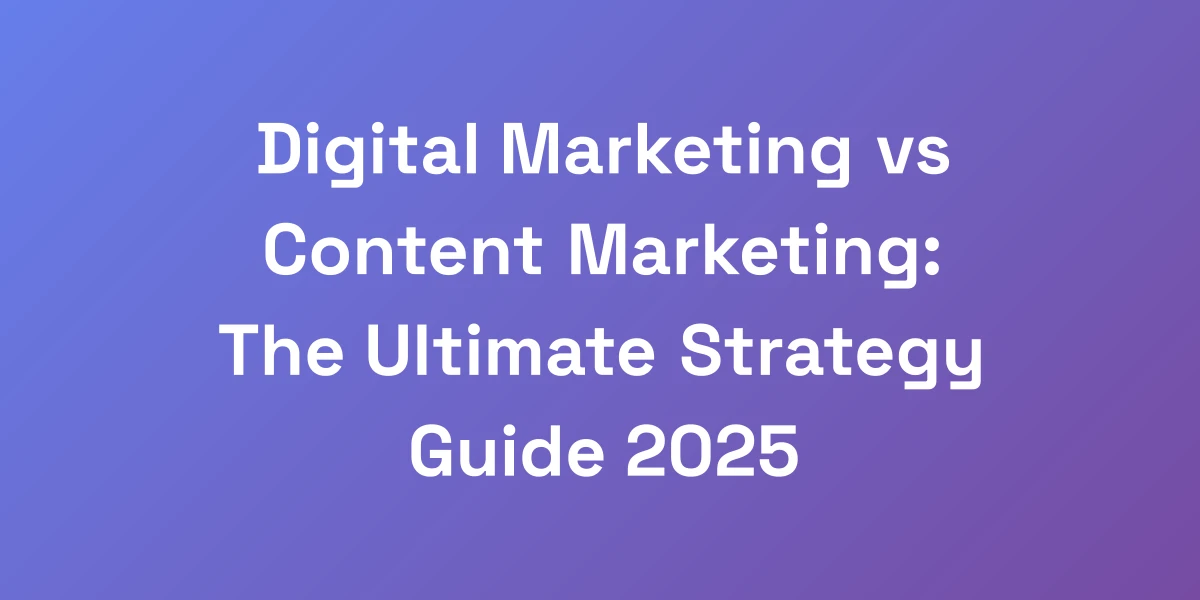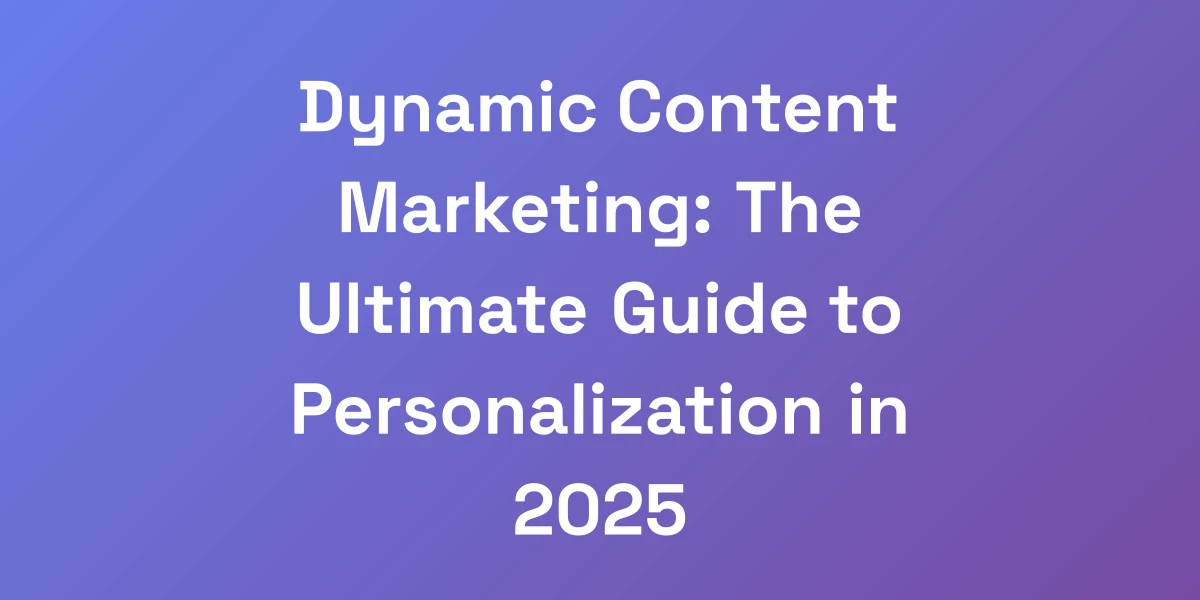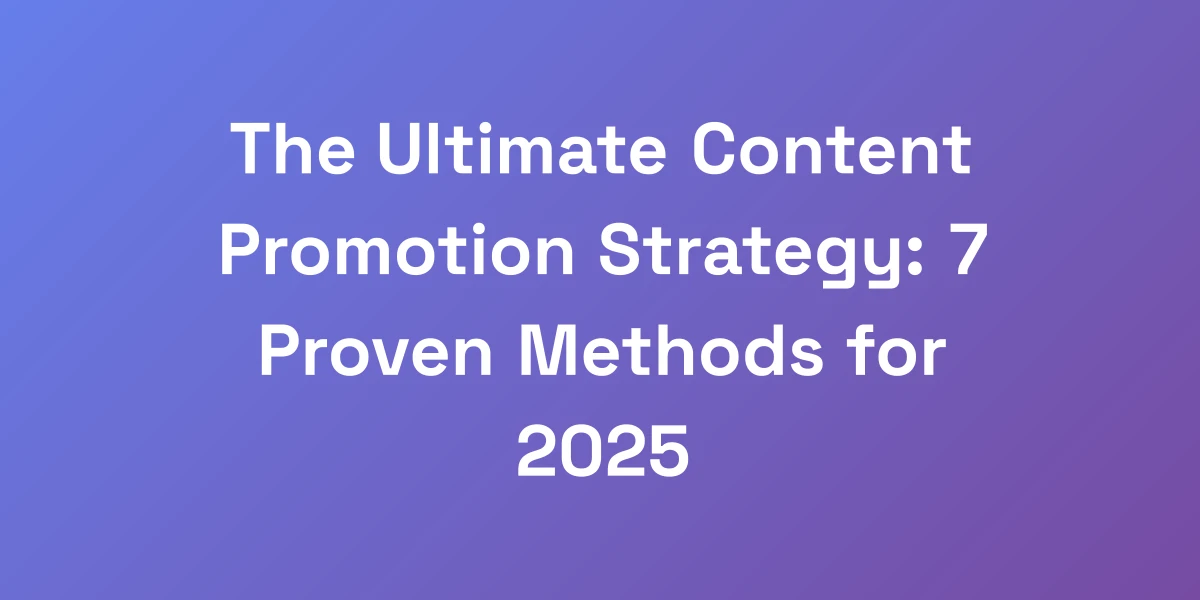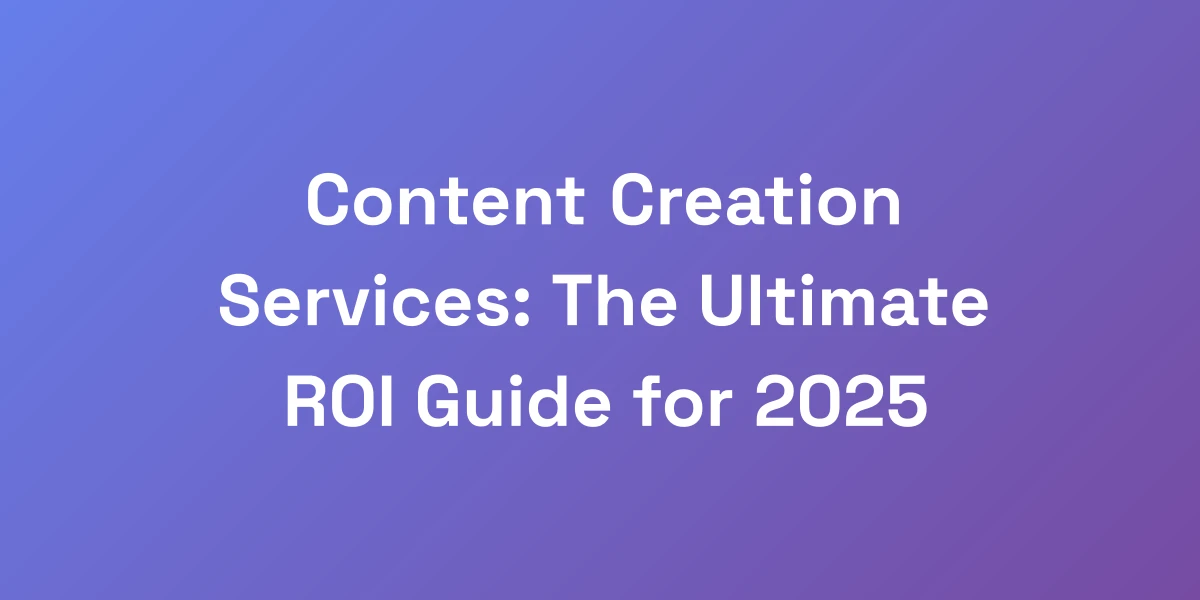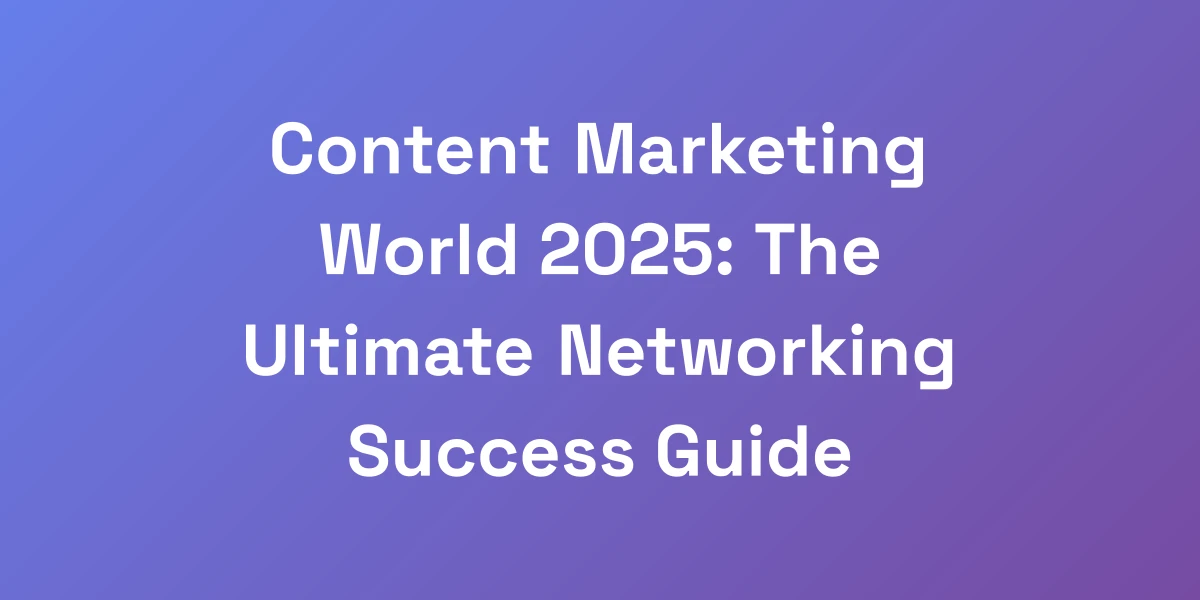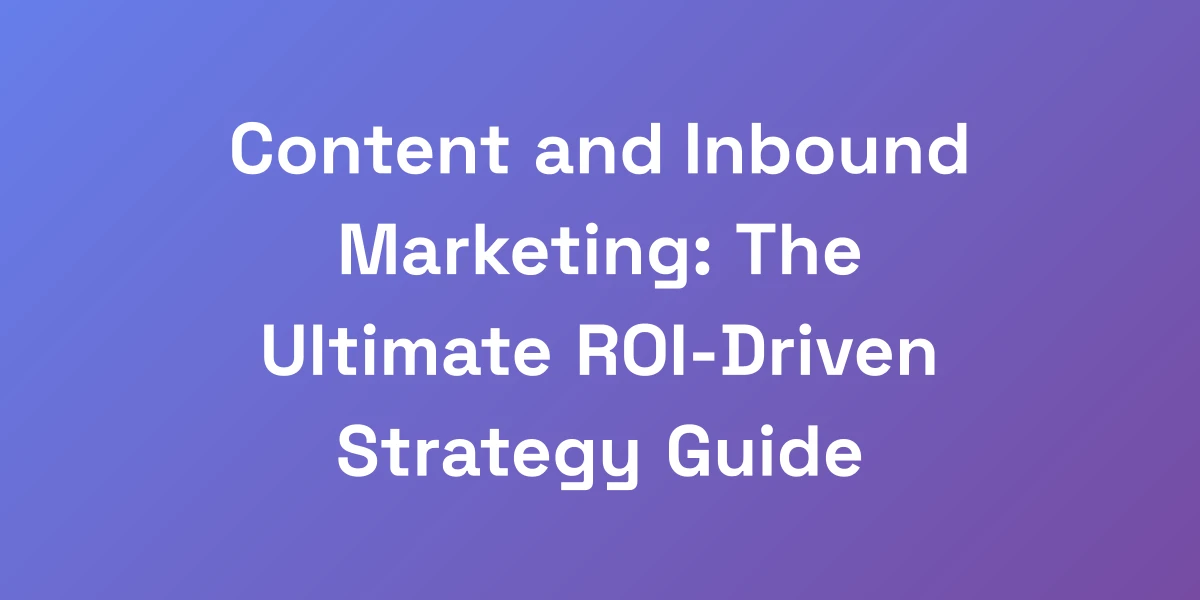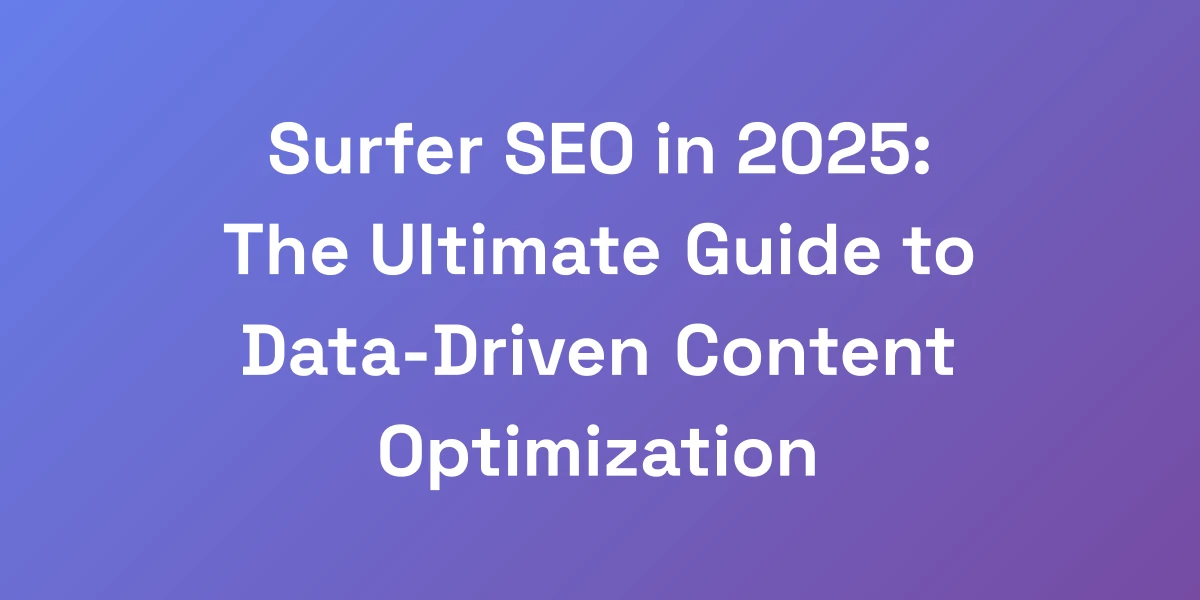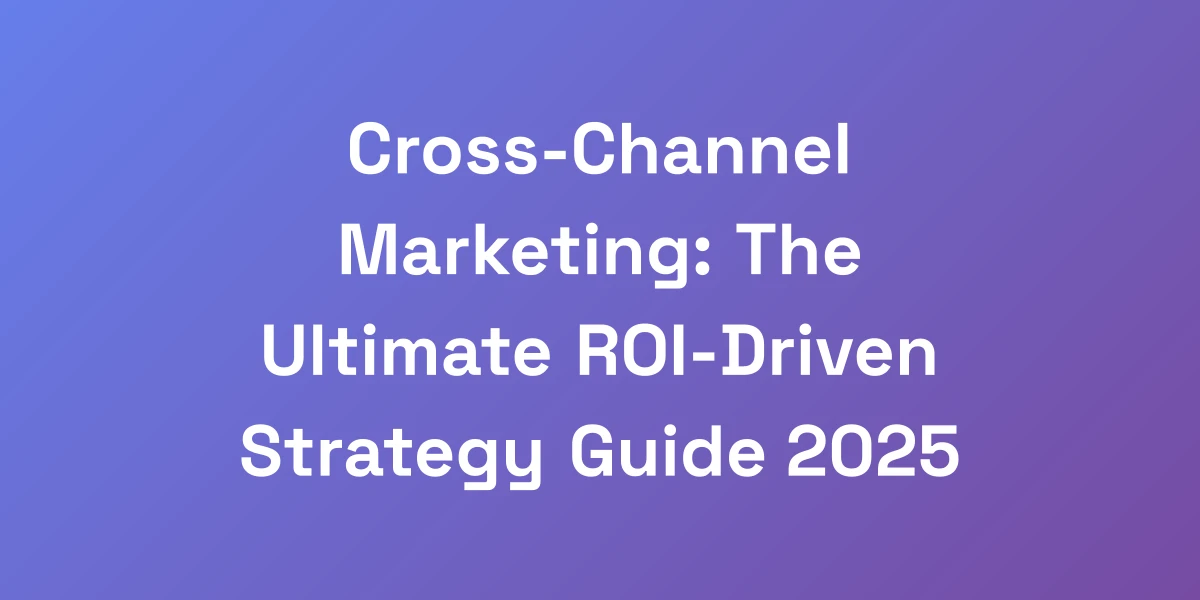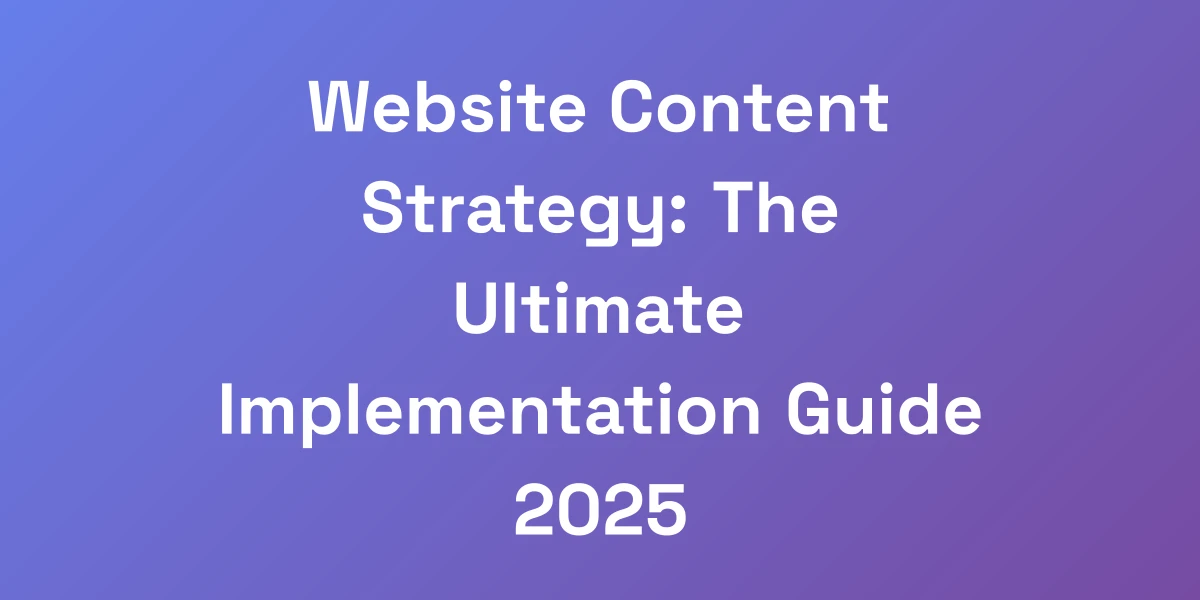
Website Content Strategy: The Ultimate Implementation Guide 2025
Feb 28, 2025 | By [email protected]
Ever felt like your website content strategy is just floating aimlessly in the vast ocean of the internet? You’re not alone.
Many of us invest countless hours and resources into creating content, only to find it doesn’t resonate or deliver the desired results. It can be incredibly frustrating to see your efforts not translating into tangible outcomes.
But what if you could turn the tide? Imagine having a crystal-clear roadmap that not only aligns with your business goals but also captivates your audience. That’s exactly what a well-crafted website content strategy can do.
In this guide, we’ll explore the intricate layers of designing and implementing a content strategy that stands out in 2025. From understanding the content marketing trends to measuring and optimizing performance, we’ve got you covered.
Ready to transform your website into a powerhouse of engagement and ROI? Let’s embark on this journey together.
Understanding Modern Website Content Strategy
Let’s dive into what a content strategy actually means in 2024. Gone are the days when simply publishing blog posts randomly would cut it. Today’s website content strategy is a sophisticated ecosystem that combines user psychology, business objectives, and digital innovation.
I’ve spent years refining my own content marketing strategy, and I’ve learned that success lies in the intersection of a scientific approach and creative execution.
Think of your content strategy as the GPS for your digital presence – without it, you’re just driving blindly through the internet landscape.
The Evolution of Content Strategy in the Digital Age
Content strategy has undergone a significant transformation over the past decade. Initially, the focus was primarily on quantity – producing as much content as possible to attract traffic.
However, with the advent of advanced SEO techniques and the rise of content saturation, the emphasis has shifted towards quality and relevance.
In 2025, a successful content strategy isn’t just about filling space; it’s about creating meaningful interactions that drive engagement and conversions.
For example, brands like HubSpot have pivoted from merely publishing blog posts to creating comprehensive resource hubs that offer unparalleled value to their audience.
Key Components of a Modern Content Strategy
Building a robust content strategy involves several critical components that work in tandem.
- Audience Understanding: Delving deep into who your audience is, their needs, and their behaviors based on global media consumption statistics.
- Content Planning: Structuring your content to align with both user intent and business goals.
- SEO Integration: Ensuring your content is optimized for search engines without sacrificing authenticity. For specialized industries, SEO for financial services provides a tailored approach that addresses unique challenges.
- Distribution Channels: Leveraging the right platforms to maximize content reach and engagement.
- Performance Measurement: Continuously analyzing content marketing benchmarks by industry to refine and improve your strategy.
Each of these components plays a pivotal role in crafting a content strategy that’s not only effective but also sustainable in the long run.
Why Traditional Content Approaches Are Failing
Traditional content approaches, which often prioritize quantity over quality, are increasingly falling short.
With users bombarded by information from every direction, standing out requires more than just frequent posting. It’s about delivering content that truly resonates and adds value.
For instance, the statistic that 83% of marketers found creating higher quality content less often is far more effective than churning out lower quality content underscores this shift.
Quality content fosters trust and authority, leading to higher engagement and better SEO performance.
The ROI of Strategic Content Planning
Investing in a strategic content plan can yield impressive returns. According to recent data, 14% of businesses said their content marketing efforts resulted in the biggest ROI in 2024.
This ROI stems from well-planned content that aligns with business objectives, effectively engages the target audience, and drives conversions.
Take the example of a fintech company that tailored its content to address the specific pain points of high net worth individuals. By doing so, they not only attracted their target audience but also established themselves as industry leaders, resulting in significant ROI.
Common Content Strategy Myths Debunked
There are several myths that can derail your content strategy if left unchecked.
- Myth 1: More content equals better results.
- Myth 2: Content strategy is solely the marketing team’s responsibility.
- Myth 3: SEO and content are separate entities.
In reality, it’s not about the sheer volume but the strategic quality of your content. Additionally, a successful content strategy requires collaboration across various departments and seamless integration of SEO practices.
By debunking these myths, we can focus on what truly matters – creating impactful content that drives meaningful results.
Building Your Content Strategy Foundation
The foundation of your content strategy is like building a high-performance engine – every component needs to work in perfect harmony.
Through my experience working with various brands and growing my own platform, I’ve discovered that successful content strategies start with razor-sharp audience understanding.
It’s not just about demographics; it’s about psychographics – understanding the deep-seated desires and pain points that drive your audience’s behavior.
Let’s break down how to create this foundation step by step.
Conducting a Comprehensive Content Audit
Before crafting new content, it’s essential to evaluate what you already have. A comprehensive content audit helps identify what’s working, what’s not, and where the gaps lie.
- Inventory Your Content: List all existing content, including blog posts, videos, infographics, and more.
- Analyze Performance: Use SEO content audit tools to assess metrics such as traffic, engagement, and SEO performance.
- Identify Gaps: Look for topics that are missing or can be expanded upon to better serve your audience.
- Evaluate Quality: Ensure that all content aligns with your current standards and brand voice.
For example, a retail brand might discover that while their blog posts drive traffic, their video content garners higher engagement, prompting a shift towards more video production.
Defining Your Content Mission Statement
Your content mission statement serves as the North Star for all your content efforts.
It clearly articulates what you aim to achieve with your content and how it supports your overall business objectives.
Creating a mission statement involves:
- Identifying Your Purpose: What is the primary goal of your content? Is it to educate, entertain, or drive conversions?
- Aligning with Business Goals: Ensure that your content objectives complement your overarching business strategies.
- Defining Your Value Proposition: What unique value does your content provide to your audience?
A strong mission statement might be: “To empower entrepreneurs with actionable insights and resources, fostering a community of innovators and leaders.”
Creating Detailed Audience Personas
Understanding your audience is crucial. Detailed audience personas help you tailor your content to meet their specific needs and preferences.
- Demographics: Age, gender, location, income level, education, etc.
- Psychographics: Interests, values, lifestyle, challenges, and motivations.
- Behavioral Traits: Buying habits, brand loyalty, content consumption patterns.
For instance, a fintech company targeting high net worth individuals might create personas that include their financial goals, preferred communication channels, and common financial challenges.
Setting SMART Content Goals
SMART goals are Specific, Measurable, Achievable, Relevant, and Time-bound. Setting SMART goals ensures that your content strategy is focused and effective.
- Specific: Define clear and precise objectives, such as increasing blog traffic by 20%.
- Measurable: Use metrics to track progress, like page views, engagement rates, or conversion rates.
- Achievable: Set realistic goals that are attainable with the resources available.
- Relevant: Align goals with your business objectives, ensuring they contribute to overall success.
- Time-bound: Establish deadlines to maintain momentum and accountability.
For example, a goal might be: “Increase email newsletter sign-ups by 15% within the next quarter by offering exclusive content and optimizing landing pages.”
Establishing Your Content Voice and Tone
Your content voice is the unique personality and style that is consistent across all your content. Tone, on the other hand, can vary depending on the context and audience.
- Voice: Decide whether your brand voice is formal, casual, authoritative, friendly, etc.
- Consistency: Maintain the same voice across all channels to build brand recognition and trust.
- Adaptability: Adjust the tone based on the type of content and the audience’s needs.
For instance, a tech startup might adopt a friendly and approachable voice for blog posts while maintaining a more authoritative tone in whitepapers and case studies.
Developing Your Content Pillars
Content pillars are the main themes or topics that support your content strategy. They ensure that your content remains focused and aligned with your audience’s interests.
- Identify Core Topics: Determine the primary areas that your audience cares about and that align with your business goals.
- Create Subtopics: Break down each pillar into more specific topics that you can explore in-depth.
- Maintain Balance: Ensure a diverse range of content within each pillar to keep your audience engaged.
For example, a health and wellness website might have content pillars like nutrition, fitness, mental health, and lifestyle. Each pillar can then have subtopics such as meal planning, workout routines, stress management, and work-life balance.
Content Creation and Distribution Framework
Here’s where the rubber meets the road. Creating content without a framework is like trying to build a house without blueprints – chaotic and inefficient.
I’ve developed a systematic approach that combines creative storytelling with strategic planning. The key is to create content that’s not just engaging but also scalable and sustainable.
Through my years of content creation, I’ve learned that the most successful content follows a clear, repeatable process while maintaining authenticity and value. Additionally, utilizing automated SEO tools can significantly enhance your content optimization efforts.
Content Types and Their Strategic Use
Different types of content serve various purposes and cater to different stages of the user journey.
- Blog Posts: Ideal for driving organic traffic and establishing authority on specific topics.
- Videos: Highly engaging and effective for demonstrating products, sharing testimonials, or creating tutorials.
- Infographics: Perfect for visual learners and simplifying complex information into digestible formats.
- eBooks and Whitepapers: Great for in-depth exploration of topics and generating leads through gated content.
- Social Media Posts: Essential for building community, fostering engagement, and promoting content.
For instance, a SaaS company might use blog posts to explain industry trends, videos to showcase product features, and webinars to engage directly with potential customers.
Creating Your Content Calendar
A content calendar is your roadmap for content creation and distribution. It ensures consistency and helps you align your content with key dates and events.
- Plan Ahead: Schedule your content at least a month in advance to stay organized and reduce last-minute stress.
- Balance Content Types: Ensure a mix of different content types to cater to various audience preferences.
- Incorporate Key Dates: Align your content with holidays, industry events, and product launches for maximum relevance.
- Set Deadlines: Assign timelines for content creation, review, and publication to maintain momentum.
For example, during the holiday season, a retail brand might plan a series of blog posts, social media campaigns, and promotional videos to boost sales and engage customers.
Content Production Workflows
Establishing efficient workflows is crucial for streamlined content production. A well-defined process reduces bottlenecks and ensures timely delivery.
- Ideation: Brainstorm topics based on your content pillars and audience needs.
- Creation: Assign tasks to writers, designers, and other team members to develop content.
- Editing: Review and refine content to ensure it meets quality standards and aligns with your voice.
- Approval: Get the necessary approvals from stakeholders before publication.
- Publication: Schedule and publish your content according to the content calendar.
- Promotion: Share your content across relevant channels to maximize reach and engagement.
Using project management tools like Trello or Asana can help keep everyone on track and ensure smooth collaboration.
Distribution Channel Strategy
Creating great content is only half the battle; effectively distributing it is equally important.
- Owned Channels: Your website, blog, email newsletters, and social media profiles are primary channels for distributing content.
- Earned Channels: Guest posts, backlinks, and mentions in industry publications help amplify your reach.
- Paid Channels: Consider using paid promotions like social media ads or sponsored content to boost visibility.
For example, a fitness brand might leverage Instagram and YouTube for visual content, collaborate with fitness influencers for broader reach, and use Facebook ads to target specific demographics. Additionally, listing your business in best local business directories can significantly enhance your local SEO efforts.
Content Repurposing Techniques
Repurposing content allows you to maximize the value of your existing content by presenting it in different formats.
- Transform Blog Posts into Videos: Convert detailed articles into engaging video content.
- Create Infographics from Data: Visualize statistics and key points to make information more digestible.
- Compile eBooks from Series: Combine related blog posts into comprehensive eBooks for lead generation.
- Share Quotes on Social Media: Extract impactful quotes or insights from your content to share as visual posts.
For instance, a marketing agency might take a series of blog posts on SEO strategies and compile them into an eBook, offering it as a free download to capture leads.
Quality Control and Editorial Guidelines
Maintaining high-quality content consistently requires clear editorial guidelines and quality control processes.
- Style Guides: Define your brand voice, tone, and formatting standards to ensure consistency.
- Review Processes: Implement multiple layers of review, including fact-checking and proofreading, to eliminate errors.
- Content Approval: Establish a clear approval hierarchy to streamline the publication process.
- Feedback Loops: Encourage team members to provide and receive feedback for continuous improvement.
For example, a health blog might have strict editorial guidelines to ensure all content is evidence-based and aligns with regulatory standards.
Measuring and Optimizing Content Performance
As a self-confessed productivity nerd, I’m obsessed with measuring and optimizing everything I do. When it comes to content strategy, data is your best friend.
But here’s the thing – it’s not about tracking every possible metric. Instead, focus on the metrics that actually matter for your specific goals.
I’ve learned through trial and error that successful content optimization is about finding the sweet spot between user engagement and business objectives.
Essential Content KPIs to Track
Key Performance Indicators (KPIs) help you measure the effectiveness of your content strategy.
- Traffic: Monitor the number of visitors to your content to gauge reach.
- Engagement: Track metrics like time on page, likes, shares, and comments to assess how your audience interacts with your content.
- Conversion Rates: Measure how well your content drives desired actions, such as signing up for a newsletter or making a purchase.
- SEO Performance: Analyze keyword rankings, backlinks, and organic traffic to evaluate your content’s search visibility.
- Lead Generation: Assess the number of leads generated through gated content like eBooks or webinars.
For example, if your goal is to increase email sign-ups, tracking conversion rates from your lead magnet pages is crucial.
Tools for Content Performance Analysis
Leveraging the right tools can make a significant difference in how you measure and analyze your content performance.
- Google Analytics 4: Offers comprehensive insights into website traffic, user behavior, and conversion tracking.
- SEMrush: Provides detailed SEO metrics, including keyword rankings and backlink analysis.
- Ahrefs: Excellent for analyzing backlinks, competitor performance, and content gaps.
- Sprout Social: Ideal for tracking social media benchmarks by industry and performance across different platforms.
- Databox: Consolidates data from various sources to provide a unified view of your content performance metrics.
Using these tools, you can gain actionable insights to refine and enhance your content strategy continually.
A/B Testing Content Elements
A/B testing involves comparing two versions of a content element to determine which performs better.
- Headlines: Test different headlines to see which one attracts more clicks.
- Call-to-Actions: Experiment with various CTAs to identify which drives higher conversions.
- Content Layout: Compare different layouts to see which one enhances user engagement.
- Visuals: Test different images or videos to determine which resonates more with your audience.
For example, you might create two versions of a blog post with different headlines and track which version garners more traffic and engagement.
Content SEO Optimization Techniques
Optimizing your content for search engines is essential for improving visibility and driving organic traffic.
- Keyword Research: Identify relevant keywords that your audience is searching for and incorporate them naturally into your content.
- On-Page SEO: Optimize title tags, meta descriptions, headers, and URL structures to enhance search engine rankings.
- Internal Linking: Link to other relevant content on your website to improve navigation and SEO.
- Mobile Optimization: Ensure your content is mobile-friendly to cater to the growing number of mobile users.
- Schema Markup: Use structured data to help search engines understand your content better and enhance your visibility in search results.
For instance, incorporating long-tail keywords and optimizing images with alt text can significantly boost your content’s SEO performance.
User Feedback Integration
Direct feedback from your audience can provide invaluable insights into how your content is perceived and what can be improved.
- Surveys and Polls: Conduct regular surveys to gather feedback on your content topics, formats, and quality.
- Comments and Reviews: Monitor comments on your blog and social media to understand audience sentiments.
- Usability Testing: Observe how users interact with your content to identify any pain points or areas for enhancement.
For example, if users frequently request more video content, you can adjust your strategy to include more video tutorials or webinars.
Iterative Improvement Process
Content strategy is not a set-it-and-forget-it endeavor. It requires continuous monitoring, analysis, and refinement.
- Regular Reviews: Schedule periodic reviews of your content performance to identify trends and areas for improvement.
- Adapt and Evolve: Be prepared to pivot your strategy based on performance data and changing audience needs.
- Implement Changes: Use the insights gained from your analysis to make informed adjustments to your content strategy.
For instance, if a particular content type is underperforming, investigate the reasons and experiment with different approaches to enhance its effectiveness.
Conclusion
Crafting a successful website content strategy in 2025 requires a blend of strategic planning, creative execution, and continuous optimization.
We’ve explored the evolution of content strategies, the essential components that form a solid foundation, and the frameworks necessary for effective content creation and distribution.
Moreover, understanding how to measure and optimize your content performance ensures that your efforts translate into meaningful results and a strong return on investment.
Remember, a well-executed content strategy is not just about creating content for the sake of it but about delivering genuine value to your audience while achieving your business goals.
Ready to take your website content strategy to the next level? Start by conducting a comprehensive content marketing statistics today, and lay down the groundwork for a strategy that drives engagement, growth, and success.
What steps will you take first to enhance your content strategy? Share your thoughts and experiences in the comments below!
